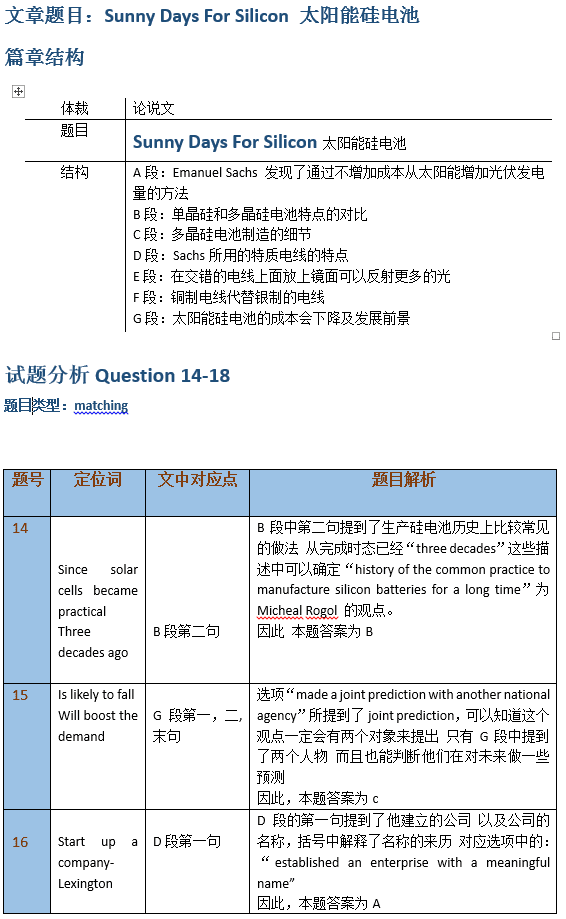托福阅读虽然是我们比较熟悉的题目,但因为题量大,涉及词汇非常多,想要拿到高分并不容易。今天小编给大家带来了托福阅读想拿高分要做到这三点,希望能够帮助到大家,下面小编就和大家分享,来欣赏一下吧。
高分技巧丨托福阅读想拿高分要做到这三点!
托福阅读高分技巧一:词汇过关
从某种意义上来讲,词汇量的大小是TOEFL阅读理解高分的基础和关键。如果词汇量没有达到基本要求(五千以上),纵然你有“葵花宝典”在手,也只能命丧ETS的“毒招”之下。所以,以牺牲词汇量为代价的技巧练习简直是一味巨毒无比。
托福阅读高分技巧二:掌握阅读方法
TOEFL的阅读量非常大,一般的中国考生根本无法把文章全部读完,所谓的“扫读法”、“跳读法”和“略读法”也只能适用于少数类型的文章,根本不能解决本质问题。那么,文章到底应该怎么读法呢?一句话,主动地阅读文章的关键部位。所谓主动是指不能象一般的阅读那样完全被动地接受信息,而应该不断的进行思考和预测;所谓关键部位,主要是每一段的开头和结尾部分。由于TOEFL的阅读理解文章全部选自于正式出版物,文章的逻辑结构非常完整和严谨,而且出现的逻辑模式也是屈指可数。经过系统的训练,考生的预测可以做到非常准确的程度。这样,通过阅读文章的几处关键部位,就能很快地把握整个文章的结构和内在的逻辑关系,也就解决了问题的70%.
托福阅读高分技巧三:多做题
排除法恐怕是一直以来大多数学生在解阅读理题目时使用多的方法。事实上,这种方法具有致命的缺点:干扰大、费时间。更有效和迅速的办法是读完题干之后,就在脑子反映出一个模糊的或者是不完整的答案,然后直接在选项中寻找接近的答案进行判断。这种能力必须在平时的训练和讲解中逐渐养成和加强,决非什么技巧之类的东西可以替代。
托福阅读之文明的起源与发展
托福阅读考察过的话题可不少,学术性文章也是大家最难以理解的,不过如果能积累足够的托福阅读资料相信对于大家一定有帮助,下面就结合托福阅读资料来看看这个问题。
大家在托福阅读文章之前可以先跳到最后一题(文章总结题)的位置看看那句对于文章总结的句子。对于大家从整体上把握文章的结构非常有帮助。
托福阅读真题再现:
版本一: 文明的起源。地方是美索不达米亚平原那边的。因为土地资源丰富,所以人口增多来开发,好像还提到了从其他地方得到青铜(bronze),所以很珍贵。一般不用来作为务农工具。有一题就是问为什么不用青铜器装农作物的。
版本二: 讲文明的起源,主要以两河流域为例。解释了文明的主要特点为有政治中心,自己的语言,金属工具等等。同事说美索不达米亚和埃及因为是何故所以进口bronze,价格昂贵作为首饰和装饰品。
解析: 本文讲文明发展史。主要讨论的是某文明发展的原因,主旨明确,结构清晰,每段首句为topic sentence的可能性较高。大家在阅读文章之前可以先跳到最后一题(文章总结题)的位置看看那句对于文章总结的句子。对于大家从整体上把握文章的结构非常有帮助。从文章结构与内容上,都非常接近TPO8的文章The Rise of Teotihucan。
相关托福阅读资料:
Sumer
Sumer (from Akkadian ?umeru; Sumerian ki-en-?ir15, approximately "land of the civilized kings" or "native land"[note 1]) was an ancientcivilization and historical region in southern Mesopotamia, modern-day southern Iraq, during the Chalcolithic and Early Bronze Age. Although the earliest forms of writing in the region do not go back much further than c. 3500 BC, modern historians have suggested that Sumer was first permanently settled between c. 5500 and 4000 BC by a non-Semitic people who may or may not have spoken the Sumerian language (pointing to the names of cities, rivers, basic occupations, etc. as evidence).[1][2][3][4] These conjectured, prehistoric people are now called "proto-Euphrateans" or "Ubaidians",[5] and are theorized to have evolved from the Samarra culture of northern Mesopotamia (Assyria).[6][7][8][9] The Ubaidians were the first civilizing force in Sumer, draining the marshes for agriculture, developing trade, and establishing industries, including weaving, leatherwork, metalwork, masonry, and pottery.[5] However, some scholars such as Piotr Michalowski and Gerd Steiner, contest the idea of a Proto-Euphratean language or one substrate language. It has been suggested by them and others, that the Sumerian language was originally that of the hunter and fisher peoples, who lived in the marshland and the Eastern Arabia littoral region, and were part of theArabian bifacial culture.[10] Reliable historical records begin much later; there are none in Sumer of any kind that have been dated beforeEnmebaragesi (c. 26th century BC). Professor Juris Zarins believes the Sumerians were settled along the coast of Eastern Arabia, today's Persian Gulf region, before it flooded at the end of the Ice Age.[11] Sumerian literature speaks of their homeland being Dilmun.
Sumerologist Samuel Noah Kramer asserts "No people has contributed more to the culture of mankind than the Sumerians" and yet it is only comparatively recently that we have built up a knowledge of the existence of this ancient culture.[12] Sumerian civilization took form in theUruk period (4th millennium BC), continuing into the Jemdat Nasr and Early Dynastic periods. During the 3rd millennium BC, a close cultural symbiosis developed between the Sumerians (who spoke a language isolate) and the Semitic Akkadian speakers, which included widespreadbilingualism.[13] The influence of Sumerian on Akkadian (and vice versa) is evident in all areas, from lexical borrowing on a massive scale, tosyntactic, morphological, and phonological convergence.[13] This has prompted scholars to refer to Sumerian and Akkadian in the 3rd millennium BC as a sprachbund.[13] Sumer was conquered by the Semitic-speaking kings of the Akkadian Empire around 2270 BC (short chronology), but Sumerian continued as a sacred language. Native Sumerian rule re-emerged for about a century in the Third Dynasty of Ur (Sumerian Renaissance) of the 21st to 20th centuries BC, but the Akkadian language also remained in use. The Sumerian city of Eridu, on the coast of the Persian Gulf, was the world's first city, where three separate cultures fused - that of peasant Ubaidian farmers, living in mud-brick huts and practicing irrigation; that of mobile nomadic Semitic pastoralists living in black tents and following herds of sheep and goats; and that of fisher folk, living in reed huts in the marshlands, who may have been the ancestors of the Sumerians.[14]
The irrigated farming together with annual replenishment of soil fertility and the surplus of storable food in temple granaries created by this economy allowed the population of this region to rise to levels never before seen, unlike those found in earlier cultures of shifting cultivators. This much greater population density in turn created and required an extensive labour force and division of labour with many specialised arts and crafts. At the same time, historic overuse of the irrigated soils led to progressive salinisation, and a Malthusian crisis which led to depopulation of the Sumerian region over time, leading to its progressive eclipse by the Akkadians of middle Mesopotamia.
Sumer was also the site of early development of writing, progressing from a stage of proto-writing in the mid 4th millennium BC to writing proper in the 3rd millennium BC .
托福阅读快速抽取句子主干的方法
对于基本的句子结构,主谓宾或是主系表大家都比较熟悉,但是对于句子里的修饰成分,大家往往熟悉名词之前的修饰成分,也就是对于前置的定语非常熟悉,但是对于名词之后的修饰成分也就是后置定语往往并不了解。
一、常见的五种后置定语要清楚。
对于基本的句子结构,主谓宾或是主系表大家都比较熟悉,但是对于句子里的修饰成分,大家往往熟悉名词之前的修饰成分,也就是对于前置的定语非常熟悉,但是 对于名词之后的修饰成分也就是后置定语往往并不了解,或者即使了解,概念也较为模糊。后置定语,顾名思义分为后置和定语两个部分。后置也就是此种短语出 现的位置是在名词之后,定语就是起到起到修饰限定作用的短语,注意是短语而不是句子,本质上相当于形容词。所以后置定语就是放在名词的后面起到限定修饰作 用的短语。基本可以划分为五种情况。1,形容词做后置定语。如:fossil available.即为可用的化石。2,介词短语做后置定语。如lava on the surface,中 on the surface介词短语修饰lava,表示为表面上的熔岩。3,现在分词短语做后置定语。如the blood vessels carrying cooled blood.中的carrying cooled blood就是现在分词短语用来修饰限定the blood vessels,理解为运载着凉的血液的血管。4,过去分词短语做后置定语,the gradual drying of the soil caused by its diminished ability中的caused by its diminished ability就是过去分词短语做后置定语修饰the gradual drying of the soil,理解为减少的能力导致的土壤的干燥。5,不定式短语做后置定语。the ability to absorb water中to absorb water限定修饰 the ability,理解为吸收水的能力。
二、句子之间的逻辑关系要抓住。
在了解了句子结构的基础之上,句子内部以及句子之间的逻辑关系也是非常重要的。常见的逻辑关系有,1,转折:but, however, yet 转折关系重在强调转折单词之后的内容。2,让步:although,though,even though,even if,despite,in spite of,nevertheless。让步关系出现在句中时,强调的是后半句,前半句被弱化。 3,比较对比:more/less than, most, as…as , while, whereas。尤其注意对比种可能多个逻辑关系词柔和在一起,如既有whereas的对比,又有more…than的比较。4,条件:if, only if, except, unless, provide that, as long as。 5,因果: because (of) ,since, as, why, for, therefore, hence, thus, thereby, consequently, accordingly, lead to, as a result (of),result in, result from, reason, A contribute to B, attribute/ascribe A to B, explain, come from, so A that B,A be responsible for B等等。在因果关系中要注意区分谁是结果,谁是原因。
在熟悉掌握句子的修饰成分和逻辑关系之后,遇到长难句时,阅读句子将不再是一个个单词的累积,而是意群的组合。这样清楚地划分出句子主干后,理解起来将会 容易得多。例 如:TPO15考察的句子简化题。In a counter current exchange system, the blood vessels carrying cooled blood from the flippers run close enough to the blood vessels carrying warm blood from the body to pick up some heat from the warmer blood vessels; thus, the heat is transferred from the outgoing to the ingoing vessels before it reaches the flipper itself. 就可以拆分为:In a countercurrent exchange system, the blood vessels( carrying cooled blood from the flippers) run close enough to the blood vessels(carrying warm blood from the body )to pick up some heat from the warmer blood vessels; thus, the heat is transferred from the outgoing to the ingoing vessels before it reaches the flipper itself. 句子逻辑关系词为thus,因此是因果关系,且前因后果。carrying cooled blood from the flippers和carrying warm blood from the body两个均为分词短语做后置定语限定修饰前面的blood vessels,这两个修饰成分搞清楚,句子结构就明朗了。即,在逆流的交换体系里,从鳍中流入的带着冷血的血管与中从身体里流出的带着暖血的血管紧密排 列,因此,热量就可以在到达鳍之前,从流出的血管转移到了流入的血管中。
托福阅读哪些题型分值大
(一)题量占比大的题型:词汇题,细节题
这两种题型在咱们的托福阅读中每篇都能达到3-6个题,两种题型总的占题量可以达到总托福阅读题量的一半以上(这还未包括否定细节题),所以对于同学们来说阅读要想在16-18分的话,这两种题型是帮助你们得分的关键,所以在今后的学习中一定要先把这两种题型掌握好。
(二) 题目分值大的题型:文章总结题,表格题
文章总结题每篇是两分,而表格题则是三分或是四分每篇。当然现在出现频率较高的还是文章总结题,虽然相比较表格题来说文章总结题只有两分每篇,但难度上相对来说要比表格题大一点。如果同学们想要托福阅读上20分的话这种题型是一定要擅长做的。所以就需要我们平时对文章框架结构方面进行大量的练习。大家可以把TPO托福阅读文章按照不同背景知识挑选出20篇文章来进行认真阅读,对每篇文章的每个段落都进行一下概况和总结,然后再对着文章总结题进行适当的练习。
(三)题型解法相关的题型:
(1)细节题(包括否细题)与推断题:这两种题型在解法上都是需要对题干进行定位(否定细节题有可能会针对题目选项来定位),定位之后在原文中找到相对应的词,最后得出答案,推断题仅仅是在最后得出答案的这一步中稍微需要大家进行一下推断而已。
(2)修辞目的题与文章总结题:两种题型都需要找文章的某个段落的主旨句或是主要论据,所以如果在做题遇到修辞目的题的时候,大家需要在头脑中记一下这种题的答案,因为很有可能就是文章总结题中会出现的正确选项。
(3)指代题与句子插入题 :这两种题型之间解法的相似性当然就是当出现代词的题目的时候,句子插入题需要按照指代题的解法思路来破题了。
托福阅读高分技巧之想拿高分要做到这三点
上一篇:托福阅读词汇复习之词汇如何背记
下一篇:托福阅读逻辑推理题怎么做






